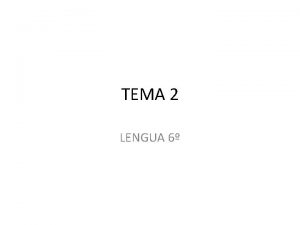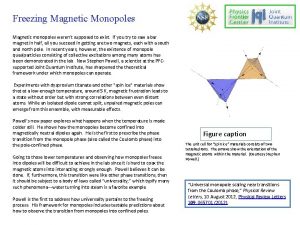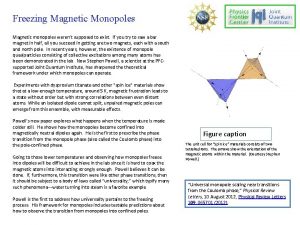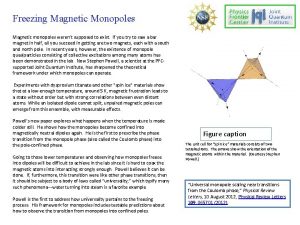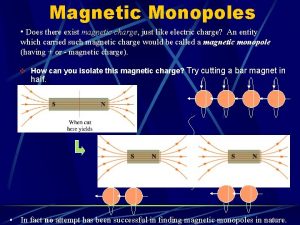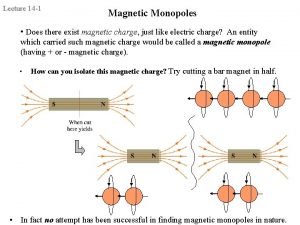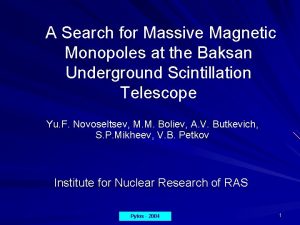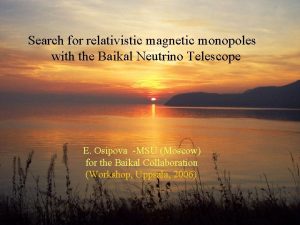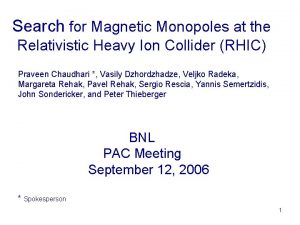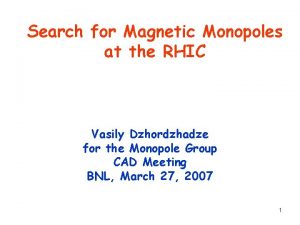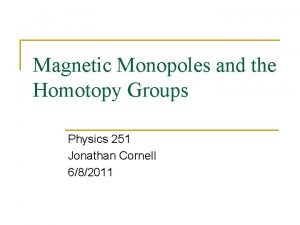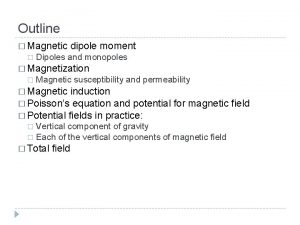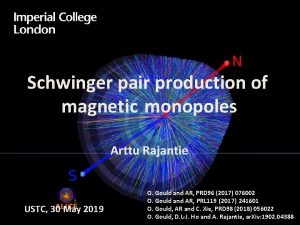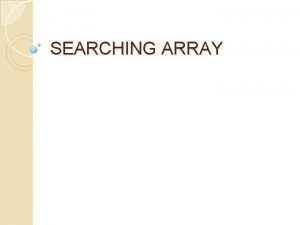Searching for Magnetic Monopoles with the Mo EDAL





















- Slides: 21

Searching for Magnetic Monopoles with the Mo. EDAL Experiment Albert De Roeck CERN, Geneva, Switzerland SUSY 2016 Melbourne July 7 2016

The Mo. EDAL Experiment

The Mo. EDAL Experiment • Mo. EDAL is an experiment for the search of heavy stable ionizing particles at LHC energies. • The Mo. EDAL experiment, the 7 th LHC experiment, was officially approved by the CERN Research Board on March 3 rd 2010 • Mo. EDAL shares the 8 th LHC IP with the LHCb experiment • Mo. EDAL is an array of passive Nuclear Track-Etch Detectors & Trapping Detectors, with a Medi. Pix chip based online radiation monitor system • The complete Mo. EDAL experiment has started data taking at the LHC in spring of 2015. • A 20% prototype of the full Trapping Detector was installed in the second half of 2012 and collected the first data. The results of these data are presented today


The Mo. EDAL Experiment -> Three subdetector systems • Passive Nuclear Track-Etch Detectors (NTDs) - 18 m 2 of CR 39 and Makrofol (for very high ionization) - Detection threshold is “charge/β > 5” • Passive Trapping Detectors (MMTs) - 800 kg of aluminium bars • Medi. Pix chip based online radiation monitor system The NTD and MMT detectors have been exchanged in December ‘ 15. These removed detector are being analysed

Magnetic Monopoles to explain the quantization of electric charge (Dirac ‘ 31) g. D is the Dirac unit magnetic charge Symmetrizes Maxwell equations! Dirac: Charge quantization consequence of angular momentum quantization in the presence of monopole ‘t Hooft, Polyakov: GUT monopoles Cho-Maison: Electroweak monopoles in the Te. V range. Recent discussion: Elis et al. : ar. Xiv: 1602. 01745 Collider signature: pair production of very highly ionizing particles! Example production process Monopoles will ‘burn’ through the plastic sheets of the experiment or get trapped in the dense material of the trapping detector

Results Based on the 2012 Prototype • Magnetic Monopole Trapper prototype deployed in September 2012 and exposed to 0. 75 fb-1 of 8 Te. V pp collisions • 160 kg Magnetic Monopole Trapper made of 198 aluminium rods of 2. 5 cm diameter and 60 cm length

Geometry Description in Geant 4 • Good knowledge of material between the IP and detector essential to determine monopole stopping position. Dominating systematics! • Implemented into XML file already containing the LHCb detector geometry. • Then used by Geant 4 within the LHCb software framework for simulating monopole propagation in the material.

Magnetometer Measurements ->Detection Method: Measure a persistent current induced in the superconducting coil of a sensitive SQUID magnetometer A DC-SQUID rock magnetometer (2 G Enterprises model 755)

Magnetometer Measurement Procedure • Output measured before, during and after the passage of the sample through the sensitive coil • Calibration with a convolution method applied to a dipole sample and cross checked with thin long thin dipoles mimicking a monopole of well known charge. • Subtract the empty holder result from the measurement. • The difference is the persistent current. If it differs from zero we have a monopole signal candidate!! Measurement of one 20 cm sample in 76 step through the SQUID Empty holder Trapper sample after subtraction of the empty holder

Measure of Magnetic Charges: Results Summary 1 D plot No values larger than 0. 18 g. D All 606 sample measurements Some device instabilities in the last part Exclude a trapped magnetic charge with |g| > 0. 5 g. D at the 99. 75% confidence level, in the full sample

Monopole Event Simulation Drell–Yan Process Two acceptance studies: Single monopoles with flat θ, φ and Ekin distributions Pair production: Drell-Yan model with spin ½ and spin-0 monopoles give different kinematics (with Mad. Graph) Energy loss simulated in Geant 4 & ar. Xiv: 1606. 01220 (see also backup) Note: non-perturbative!

Acceptance for spin ½ and spin 0 Trapping acceptance Assuming (LO) Drell-Yan production kinematics

Acceptance for Single Monopoles Studied for a magnetic charge of up to 6 g. D

First Analysis & Paper… April 2016

Limits for Different Monopole Charges Search results versus the monopole mass ar. Xiv: 1509. 08059 ATLAS 8 Te. V Limits on masses in the range of 100 Ge. V < m < 3500 Ge. V In particular sensitive to high magnetic charges (new at the LHC!)

Limits for Different Monopole Charges Search results versus the monopole charge DY cross section are calculated at leading order but note that perturbative calculations are not reliable due to large coupling

Comparison with other Measurements

Mo. EDAL in Run-2

Summary • The first results from Mo. EDAL, a dedicated LHC experiment for the search of heavy stable ionizing particles have been released, using a 160 kg prototype Magnetic Monopole Trapper, and based on 0. 75 fb-1 of data at 8 Te. V • The samples have been analysed by a SQUID magnetometer • No monopole candidates with a magnetic charge of ≥ 0. 5 g. D were found in the full trapping sample. • Under the assumption of a DY production at LO, mass limits are obtained for magnetic charge of up to 3 g. D • Model independent results put a 95% CL upper limit of 10 fb for magnetic charges up to 6 g. D • 2015 data (trapper and plastic foils) being analysed. • Detector is equipped for the 2016 run and collecting data since the start of the run.

Heavy Ionizing Particles
 Monopole
Monopole Prefijos de superioridad
Prefijos de superioridad Magnetic moment and magnetic field relation
Magnetic moment and magnetic field relation Force on a charged particle
Force on a charged particle Coercivity
Coercivity Permeability unit
Permeability unit Atmosfr
Atmosfr Stickprovsvariansen
Stickprovsvariansen Rutin för avvikelsehantering
Rutin för avvikelsehantering Biologiska arvet
Biologiska arvet Presentera för publik crossboss
Presentera för publik crossboss Myndigheten för delaktighet
Myndigheten för delaktighet Debattartikel mall
Debattartikel mall Kung som dog 1611
Kung som dog 1611 Tobinskatten för och nackdelar
Tobinskatten för och nackdelar Tack för att ni lyssnade bild
Tack för att ni lyssnade bild Vad är referatmarkeringar
Vad är referatmarkeringar Frger
Frger Mjälthilus
Mjälthilus Verifikationsplan
Verifikationsplan Rbk-mätning
Rbk-mätning Lufttryck formel
Lufttryck formel

